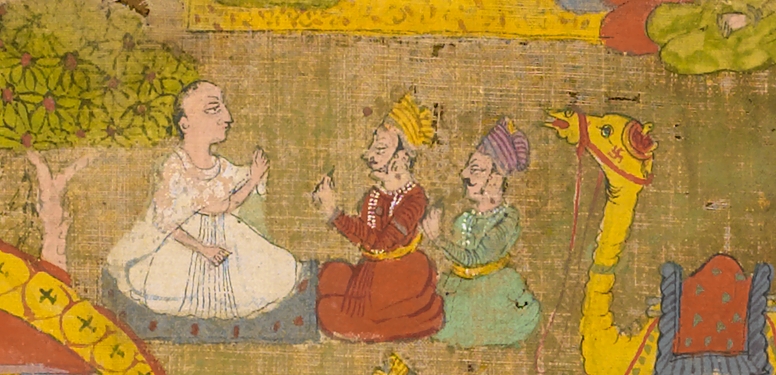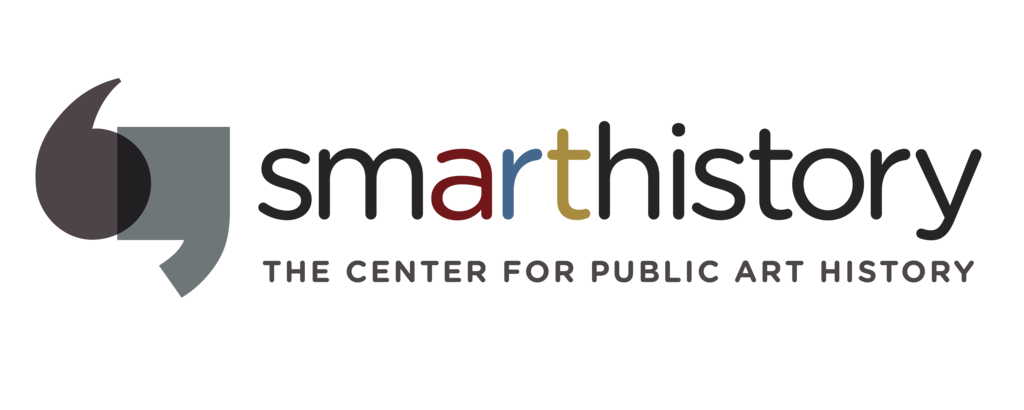
A white robed monk in discussion with attentive laymen, Jain pilgrimage map, c. 1750, Rajasthan, opaque watercolor and gold on cotton, 77 x 96 cm (Brooklyn Museum)
Qualifications
Contributors have earned a Ph.D. in a relevant discipline and have significant teaching experience, or in instances outside traditional academic disciplines, hold other appropriate qualifications. In addition to art historians, we regularly work with Ph.D.-level scholars in fields such as archaeology, conservation, history, and material anthropology, and knowledge-bearers.
Topics
We prioritize works of art that are (or should be) taught in undergraduate art history courses. Working together with contributing editors who have expertise in specific areas of art history, we have already identified many of these works of art for you to choose from. Contributors may also suggest a new topics that are not listed on the board. For any of our specialized subject areas, we will put you in touch with the appropriate contributing editor for coordination.
Ideally, we would like to offer a video and an essay for each work of art we cover. If there is a work of art that is already covered by a video, and you would like to contribute an essay on the same topic, please let us know.
Images
Please link to high-quality reference images and ancillary illustrations, such as maps, diagrams, and other relevant resources. If you happen to have high-quality photographs that you have taken or have permission to use, we can include them (these are often particularly helpful if the topic of the essay is under-represented in the curriculum).
In many cases, we have photographs already, or we can easily find openly-licensed images to augment your essay. We have more than a decade of experience doing academic image research for online publication and we are happy to work with you to make the illustrations as rich as possible.
Audience
Smarthistory essays are viewed by millions of learners from around the world. Our audience is comprised largely of undergraduates, Advanced Placement (U.S. high school) art history, and A-Level (U.K.) students taking their first art history class (whether it be a survey or a more specialized course). Graduate students studying for their comprehensive exams also use Smarthistory, as do museum visitors and other informal learners. We want our visitors to fall in love with our discipline the way we did, so we are looking for essays that emulate the accessible, engaging, and experiential narratives that we tell in the classroom (and not original research).
Essay requirements
Writing engaging public art history comes with significant responsibilities. These include:
- Target (in terms of both language and ideas) beginning art history students
- Be experiential, engaging, conversational, and approachable in tone
- Include visual analysis, leading the reader through the work of art
- Keep in mind that anything discussed in the essay will need be illustrated with images
- Begin with a “hook” to draw the learner in and make them want to learn more
- Keep the essay to 1000–1500 words long
- Focus on only a single work of art or monument
- Convey the relevance and importance of the work of art or monument
- Assume that the reader is curious but happens to know nothing about the topic, and may not have seen any other essay or video on our website
- Include definitions for specialized terms offered within the text (parenthetically or with a 1–2 sentence definition that we can make pop-up, like this)
Peer review
Smarthistory’s primary audience is made up of undergraduates, most of whom are not art history majors. In general, we want to provide students with well-accepted, up-to-date narratives about the history of art. As a result, we do not publish new scholarly research. This has lead us to develop a review process that is distinct from that used by traditional journals and academic presses. For example, every essay that we publish on the art of Africa is reviewed by two to three art historians with Ph.D.s, with at least one with expertise in the art of Africa. This has led us to an open peer review process.
Contributions to Smarthistory have been accepted by both tenure and promotion committees as well as by sabbatical committees. However, because submissions do not constitute original research, value is commonly awarded for service to the discipline rather than for published research or as a publication like a textbook. Since peer review is closely tied to the publication of original research, this has not been an issue for our contributors who tell us that they contribute to Smarthistory because they want to make art history accessible to learners around the globe, including those who may not have access to elite colleges and universities.
Get in touch
Please send a quick introduction, an up-to-date CV, and up to three works of art or monuments suitable for the undergraduate classroom you’d like to write about. (Please take a look at example essays below to get an idea of object-focused essays.)
Annotated example essays
The following two Google docs show example Smarthistory essays with annotations that refer to the Smarthistory style guidelines.
Annotated Smarthistory essay: Still Life with Peaches
Annotated Smarthistory essay: Illustration from the Akbarnama
Example essays (without annotations)
Citation style
Smarthistory uses a modified version of the Chicago Manual of Style note format. Below are examples of formatting for common types of references. Note that we use “p.” or “pp.” before page numbers. We can help with any questions about exceptions or non-standard sources.
Book:
Andrew Wallace-Hadrill, Herculaneum: Past and Future (London: Frances Lincoln Limited, 2011).
Journal article:
Julie Solometo, “The Context and Process of Pueblo Mural Painting in the Historic Era,” Kiva, volume 76, number 1 (2010), pp. 83–116.
Essay style checklist
-
- ❒ Essay length: 1000–1500 words (this can be modified in some cases)
-
- ❒ Writing is engaging, conversational, and at times even experiential
-
- ❒ Starts with a “hook” to draw the learner in and make them want to continue reading
-
- ❒ Makes the case for why the reader should care about this topic
-
-
- ❒ Specialized terms (geographic, religious, political, and methodological) are defined in parentheses (we will often turn these into pop-up definitions, like this).
- ❒ Content is object-based. Biography, historical context, and other information flows from the discussion of the object or monument
-
-
- ❒ Short engaging subheadings (1–5 words) are included that organize the content into easy-to-read sections and to invite the reader to explore further (this is essential for web-based text)
- ❒ Time is spent on formal analysis that invites the reader to carefully examine the work of art by making reference to details that we can illustrate
-
- ❒ Only essential dates are included in the text (we generally do not include birth and death dates or the dates of the reign of a ruler unless it is absolutely necessary)
-
- ❒ Footnotes are included for direct quotes and for some other circumstances, but are kept to a minimum
- ❒ A list of additional resources (both online and print) is included below the essay (the first link should be to the institution, or site where the object can be found). A short bibliography can offer direction for further study, but need not be exhaustive. You can find information about citation style on our “contribute an essay” page.
- ❒ A succinct but compelling conclusion is included (just a few sentences)

